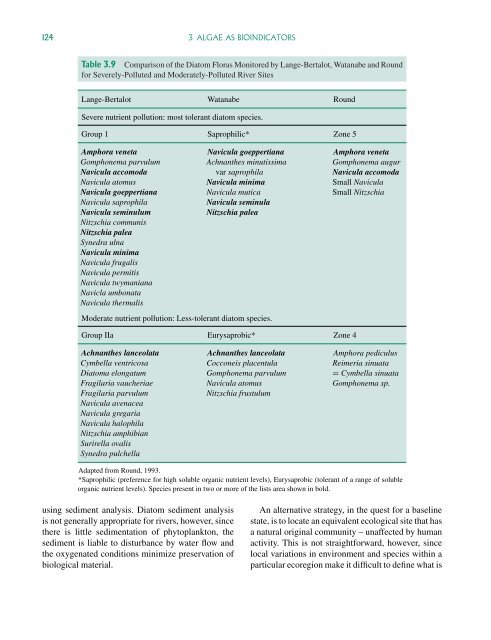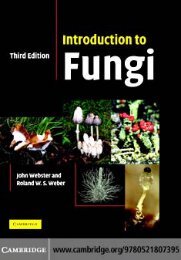Freshwater Algae: Identification and Use as Bioindicators
Freshwater Algae: Identification and Use as Bioindicators
Freshwater Algae: Identification and Use as Bioindicators
Create successful ePaper yourself
Turn your PDF publications into a flip-book with our unique Google optimized e-Paper software.
124 3 ALGAE AS BIOINDICATORSTable 3.9 Comparison of the Diatom Flor<strong>as</strong> Monitored by Lange-Bertalot, Watanabe <strong>and</strong> Roundfor Severely-Polluted <strong>and</strong> Moderately-Polluted River SitesLange-Bertalot Watanabe RoundSevere nutrient pollution: most tolerant diatom species.Group 1 Saprophilic* Zone 5Amphora venetaGomphonema parvulumNavicula accomodaNavicula atomusNavicula goeppertianaNavicula saprophilaNavicula seminulumNitzschia communisNitzschia paleaSynedra ulnaNavicula minimaNavicula frugalisNavicula permitisNavicula twymanianaNavicla umbonataNavicula thermalisNavicula goeppertianaAchnanthes minutissimavar saprophilaNavicula minimaNavicula muticaNavicula seminulaNitzschia paleaAmphora venetaGomphonema augurNavicula accomodaSmall NaviculaSmall NitzschiaModerate nutrient pollution: Less-tolerant diatom species.Group IIa Eurysaprobic* Zone 4Achnanthes lanceolataCymbella ventricosaDiatoma elongatumFragilaria vaucheriaeFragilaria parvulumNavicula avenaceaNavicula gregariaNavicula halophilaNitzschia amphibianSurirella ovalisSynedra pulchellaAchnanthes lanceolataCocconeis placentulaGomphonema parvulumNavicula atomusNitzschia frustulumAmphora pediculusReimeria sinuata= Cymbella sinuataGomphonema sp.Adapted from Round, 1993.*Saprophilic (preference for high soluble organic nutrient levels), Eurysaprobic (tolerant of a range of solubleorganic nutrient levels). Species present in two or more of the lists area shown in bold.using sediment analysis. Diatom sediment analysisis not generally appropriate for rivers, however, sincethere is little sedimentation of phytoplankton, thesediment is liable to disturbance by water flow <strong>and</strong>the oxygenated conditions minimize preservation ofbiological material.An alternative strategy, in the quest for a b<strong>as</strong>elinestate, is to locate an equivalent ecological site that h<strong>as</strong>a natural original community – unaffected by humanactivity. This is not straightforward, however, sincelocal variations in environment <strong>and</strong> species within aparticular ecoregion make it difficult to define what is
















